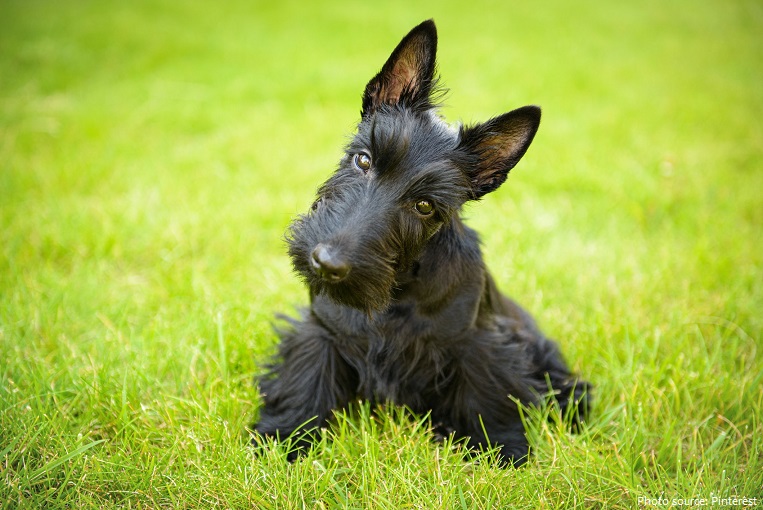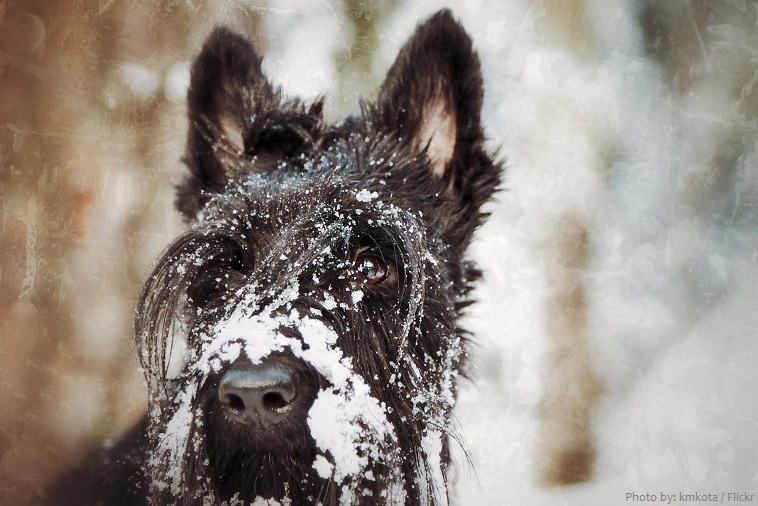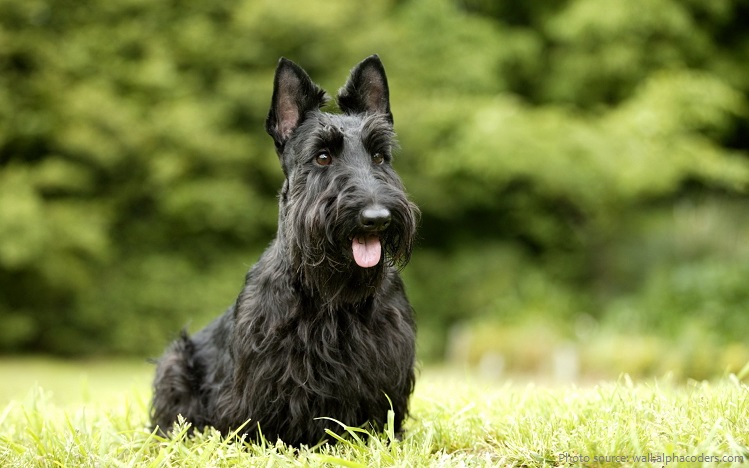
The Scottish Terrier popularly called the Scottie, is a breed of dog.
This breed’s name on Scottish Gaelic is Abhag Albannach and is also known as the Aberdeen Terrier.
Initially one of the highland breeds of terrier that were grouped under the name of Skye Terrier, it is one of five breeds of terrier that originated in Scotland, the other four being the modern Skye, Cairn, Dandie Dinmont, and West Highland White Terriers.
With a distinctive head and ‘beard,’ these dogs give off a dignified and serious air—and this is often indicative of their general disposition.

The Scottie is a somewhat reserved dog that is always alert and vigilant, as most terriers are. But behind the serious nature is a loyal dog with a heritage of hard work.
The average lifespan of the Scottish Terrier is 12 to 15 years.
Height at withers for both genders should be roughly 25 cm (9.8 in), and the length of back from withers to tail is roughly 28 cm (11 in). It is about 25 to 28 cm (10 to 11 inches) in height. Generally a well-balanced Scottie dog should weigh from 8 to 10 kg (18 to 22 lb).

The Scottish Terrier typically has a hard, wiry outer coat with a soft, dense undercoat. The coat should be trimmed and blended into the furnishings to give a distinct Scottish Terrier outline. The longer coat on the beard, legs and lower body may be slightly softer than the body coat but should not be or appear fluffy.
The coat colors range from dark gray to jet black and brindle, a mix of black and brown. Scotties with wheaten (straw to nearly white) coats sometimes occur, and are similar in appearance to the Soft-Coated Wheaten Terrier or West Highland White Terrier.
Developed to hunt rats, foxes, and badgers on the craggy Scottish Highlands, the Scottish Terrier is a venerable breed. In fact, it is thought to be the oldest of the Highland terriers. And one authority calls the breed “the oldest variety of the canine race indigenous to Britain.”

The actual origin of a breed as old as the Scottish Terrier is obscure and undocumented. The first written records about a dog of similar description to the Scottish Terrier dates from 1436, when Don Leslie described them in his book The History of Scotland 1436–1561.
Two hundred years later, Sir Joshua Reynolds painted a portrait of a young girl caressing a dog similar in appearance to the modern-day Scottie. King James VI of Scotland was an important historical figure featuring in the Scottish Terrier’s history.
In the 17th century, when King James VI became James I of England, he sent six terriers—thought to be forerunners of the Scottish terrier—to a French monarch as a gift. His love and adoration for the breed increased their popularity throughout the world.

In the later 1800’s, dog shows gained in popularity and breed enthusiasts found it necessary to further differentiate between breed types for exhibition purposes. As a result, the Skye terriers were eventually
separated into distinct breeds—the Scottish terrier, Skye terrier, West Highland white terrier, and Cairn terrier. As a result, a breed standard for the Scottie was established and served as a foundation for early breeding programs.
In 1881, a breed specific club was formed to support the burgeoning breed: the Scottish Terrier Club of England.
The early 1900s saw moderate interest in the breed, but the striking Scottie was about to enter its heyday as the war years unfolded and the Great Depression gripped the US.

Scotties were introduced to America in the early 1890s, but it was not until the years between World War I and World War II that the breed became popular.
The Scottish Terrier Club of America (STCA) was formed in 1900 and a standard written in 1925. The Scottish Terrier was recognized by the United Kennel Club in 1934.
By 1936, Scotties were the 3rd most popular breed in the United States. Although they did not permanently stay in fashion, they continue to enjoy a steady popularity with a large segment of the dog-owning public across the world.

The Scottie and the German Shepherd are the only breeds of dog that have lived in the White House more than three times. President Franklin D. Roosevelt was renowned for owning a Scottie named Fala, a gift from his distant cousin, Margaret Suckley. The President loved Fala so much that he rarely went anywhere without him. Roosevelt had several Scotties before Fala, including one named Duffy and another named Mr. Duffy. Eleanor Roosevelt had a Scottish Terrier named Meggie when the family entered the White House in 1933. More recently, President George W. Bush has owned two black Scottish Terriers, Barney and Miss Beazley. Barney starred in nine films produced by the White House.
Other famous people who are known to have owned Scotties include: Queen Victoria, Eva Braun, Dwight D. Eisenhower, Jacqueline Kennedy Onassis, Ed Whitfield, Rudyard Kipling, Gilbert Chesterton and President of Poland, Lech Kaczyński.
The Scottie is also renowned for being featured in the popular board game, Monopoly, as a player token. When the game was first created in the 1930s, Scotties were one of the most popular pets in the United States, and it is also one of the most popular Monopoly game tokens, according to Matt Collins, vice president of marketing for Hasbro.
In Disney’s 1955 film Lady and the Tramp, a Scottish terrier named Jock is the friend of Lady, the American Cocker Spaniel.
Usually, the average price of an Scottish Terrier puppy from a reputable breeder is between $1,400 and $2,000, while a top-quality Scottish Terrier puppy can cost as high as $3,500.